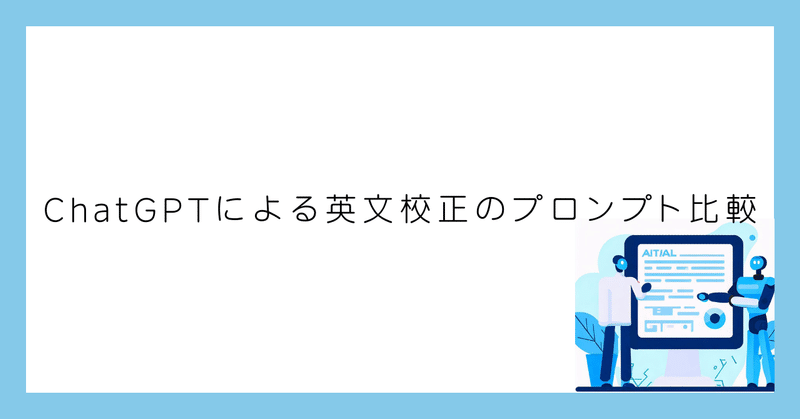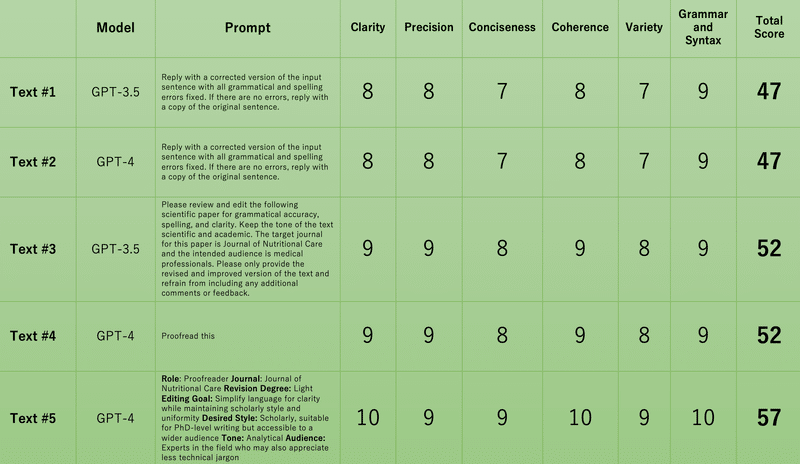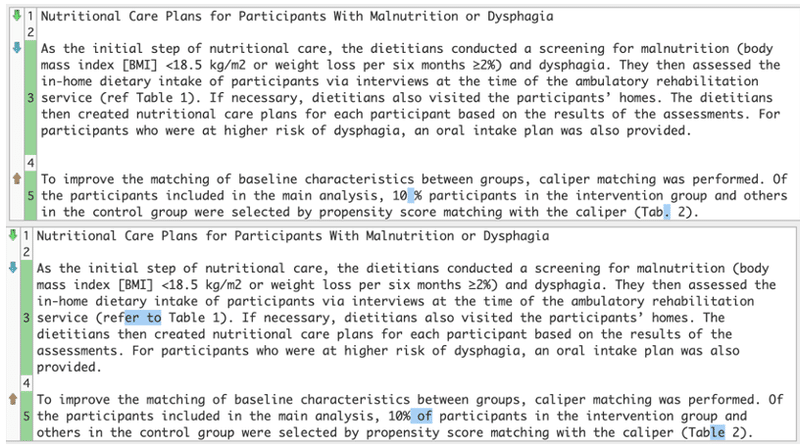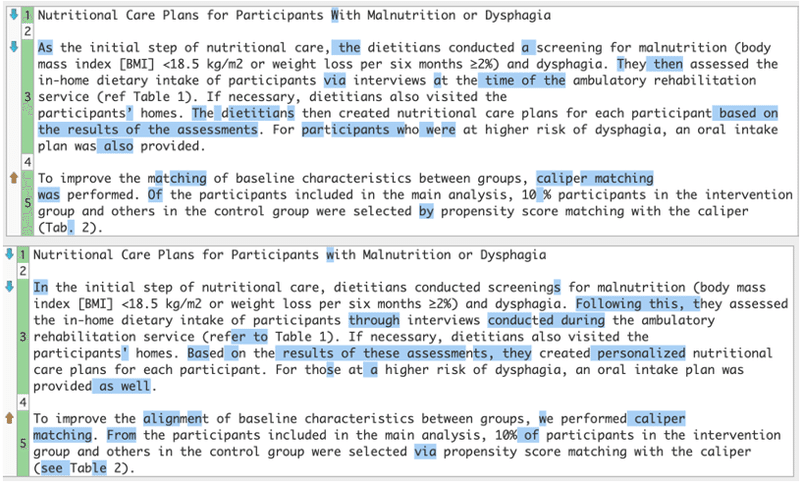
ChatGPTによる英文校正のプロンプト比較
英文校正のプロンプトも色々あってどれが実際良い校正結果になるのか分かりにくいですよね。
https://arxiv.org/pdf/2303.14342.pdf
今回はこちらの論文で紹介されていた英文校正のプロンプトと私の以前推奨していたプロンプトの比較をGPT-4に行ってもらいたいと思います
免責事項
1つの文章で1回の試行しかせず評価はGPT-4にしてもらっていますのであくまでエンタメとして見てください
「良い英文校正」の基準には色々あると思いますが、今回は 英語が苦手な大学院生が書いた論文を流暢な英語かつ文法的に正しい英語に校正することを重視している評価基準と考えてください
下記の論文のpromptは文法的な正しさを追及していますので今回の評価基準とは違うことにも留意ください
英文校正promptで一番成績が良かったもの👇👇
— 限界助教|ChatGPTで論文作成と科研費申請 (@genkAIjokyo) June 17, 2023
Reply with a corrected version of the input sentence with all grammatical and spelling errors fixed. If there are no errors, reply with a copy of the original sentence.
東北大と理研からの報告https://t.co/GzLH3D4Dmf pic.twitter.com/BdqekUxwg2
まず結論
以下のpromptをGPT-4に入れた時が一番、(ChatGPTによる)文章の評価が高くなっていました。
Role: Proofreader
Journal: Journal of Nutritional Care
Revision Degree: Light
Editing Goal: Simplify language for clarity while maintaining scholarly style and uniformity
Desired Style: Scholarly, suitable for PhD-level writing but accessible to a wider audience
Tone: Analytical
Audience: Experts in the field who may also appreciate less technical jargon
Provide Text for Editing: 
ではそれぞれのpromptについて見ていきます
Paperpalのデモから文章をお借りします
Nutritional Care Plans for Participants With Malnutrition or Dysphagia
As the initial step of nutritional care, the dietitians conducted a screening for malnutrition (body mass index [BMI] <18.5 kg/m2 or weight loss per six months ≥2%) and dysphagia. They then assessed the in-home dietary intake of participants via interviews at the time of the ambulatory rehabilitation service (ref Table 1). If necessary, dietitians also visited the participants’ homes. The dietitians then created nutritional care plans for each participant based on the results of the assessments. For participants who were at higher risk of dysphagia, an oral intake plan was also provided.
To improve the matching of baseline characteristics between groups, caliper matching was performed. Of the participants included in the main analysis, 10 % participants in the intervention group and others in the control group were selected by propensity score matching with the caliper (Tab. 2).
テキスト1 (GPT-3.5)
プロンプト
Reply with a corrected version of the input sentence with all grammatical and spelling errors fixed.
If there are no errors, reply with a copy of the original sentence.
Nutritional Care Plans for Participants With Malnutrition or Dysphagia
As the initial step of nutritional care, the dietitians conducted a screening for malnutrition (body mass index [BMI] < 18.5 kg/m² or weight loss per six months ≥ 2%) and dysphagia. They then assessed the in-home dietary intake of participants via interviews at the time of the ambulatory rehabilitation service (refer to Table 1). If necessary, dietitians also visited the participants' homes. The dietitians then created nutritional care plans for each participant based on the results of the assessments. For participants who were at higher risk of dysphagia, an oral intake plan was also provided.
To improve the matching of baseline characteristics between groups, caliper matching was performed. Of the participants included in the main analysis, 10% of participants in the intervention group and others in the control group were selected by propensity score matching with the caliper (Table 2).
テキスト2(GPT-4)
プロンプト
Reply with a corrected version of the input sentence with all grammatical and spelling errors fixed.
If there are no errors, reply with a copy of the original sentence.
Nutritional Care Plans for Participants With Malnutrition or Dysphagia
As the initial step of nutritional care, the dietitians conducted a screening for malnutrition (body mass index [BMI] <18.5 kg/m2 or weight loss per six months ≥2%) and dysphagia. They then assessed the in-home dietary intake of participants via interviews at the time of the ambulatory rehabilitation service (refer to Table 1). If necessary, dietitians also visited the participants’ homes. The dietitians then created nutritional care plans for each participant based on the results of the assessments. For participants who were at higher risk of dysphagia, an oral intake plan was also provided.
To improve the matching of baseline characteristics between groups, caliper matching was performed. Of the participants included in the main analysis, 10% of participants in the intervention group and others in the control group were selected by propensity score matching with the caliper (Table 2).
テキスト3(GPT-3.5)
プロンプト
Please review and edit the following scientific paper for grammatical accuracy, spelling, and clarity.
Keep the tone of the text scientific and academic.
The target journal for this paper is Journal of Nutritional Care and the intended audience is medical professionals.
Please only provide the revised and improved version of the text and refrain from including any additional comments or feedback.
Nutritional Care Plans for Participants with Malnutrition or Dysphagia
As the initial step in nutritional care, dietitians conducted a screening for malnutrition (body mass index [BMI] <18.5 kg/m2 or weight loss per six months ≥2%) and dysphagia. They then assessed the in-home dietary intake of participants through interviews during the ambulatory rehabilitation service (see Table 1). If necessary, dietitians also visited the participants' homes. Subsequently, the dietitians developed individualized nutritional care plans for each participant based on the assessment results. For participants at a higher risk of dysphagia, an oral intake plan was additionally provided.
To enhance the matching of baseline characteristics between groups, caliper matching was performed. From the participants included in the main analysis, 10% of participants in the intervention group and an equivalent number in the control group were selected through propensity score matching with the caliper (Table 2).
テキスト4(GPT-4)
プロンプト
Proofread this:
Nutritional Care Plans for Participants with Malnutrition or Dysphagia
In the initial step of nutritional care, dietitians conducted screenings for malnutrition (body mass index [BMI] <18.5 kg/m2 or weight loss per six months ≥2%) and dysphagia. Following this, they assessed the in-home dietary intake of participants through interviews conducted during the ambulatory rehabilitation service (refer to Table 1). If necessary, dietitians also visited the participants' homes. Based on the results of these assessments, they created personalized nutritional care plans for each participant. For those at a higher risk of dysphagia, an oral intake plan was provided as well.
To improve the alignment of baseline characteristics between groups, we performed caliper matching. From the participants included in the main analysis, 10% of participants in the intervention group and others in the control group were selected via propensity score matching with the caliper (see Table 2).
テキスト5(GPT-4)
プロンプト
Role: Proofreader
Journal: Journal of Nutritional Care
Revision Degree: Light
Editing Goal: Simplify language for clarity while maintaining scholarly style and uniformity
Desired Style: Scholarly, suitable for PhD-level writing but accessible to a wider audience
Tone: Analytical
Audience: Experts in the field who may also appreciate less technical jargon
Provide Text for Editing: Nutritional Care Plans for Individuals with Malnutrition or Dysphagia
The first step in nutritional care involved dietitians screening for malnutrition (body mass index [BMI] <18.5 kg/m2 or weight loss of ≥2% over six months) and dysphagia. Following this, dietitians evaluated participants' dietary intake at home using interview techniques during their outpatient rehabilitation service visits (see Table 1). Home visits were also conducted when required. Based on these evaluations, dietitians formulated individualized nutritional care plans. For those with an increased risk of dysphagia, plans for oral intake were additionally provided.
To better align baseline characteristics across groups, we employed caliper matching. For the primary analysis, 10% of participants in the intervention group and a corresponding group in the control group were selected using propensity score matching with the caliper (see Table 2).
ChatGPTの講評
Texts #1 and #2 are similar with minor differences in formatting (spacing before units) and punctuation (use of an apostrophe). They are generally clear, precise, and coherent, but could be slightly more concise.
Text #3, #4 and #5 provide a higher degree of clarity and precision, with better word variety and more concise expressions. Text #5, with its more natural language and better flow, ranks highest in all the categories.
論文で紹介されていたpromptは文法的な正しさを追及するのに対して後半3つのpromptは論文としての読みやすさや言い回しの自然さも指摘してくれているように思います。(ただ私の英語力では#3、4と#5の良し悪しはよくわかりません)校正にどこまでを求めるかは好みも大きいと思いますが英文校正に出してハズレの校正者に当たるよりはGPT-4に適切なpromptを入れてやってもらった方が良さそうなのは間違いないと思います。
ChatGPTで論文を書く場合はこちら
ChatGPTによる英文校正の記事です
英文校正ツールの比較記事はこちら
この記事が気に入ったらサポートをしてみませんか?
